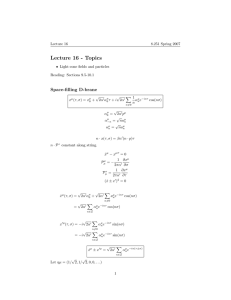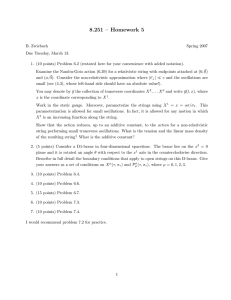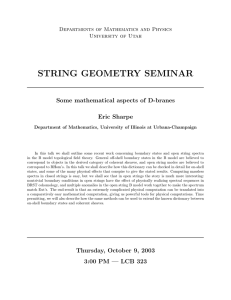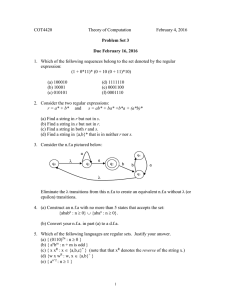8.821 String Theory MIT OpenCourseWare Fall 2008
advertisement
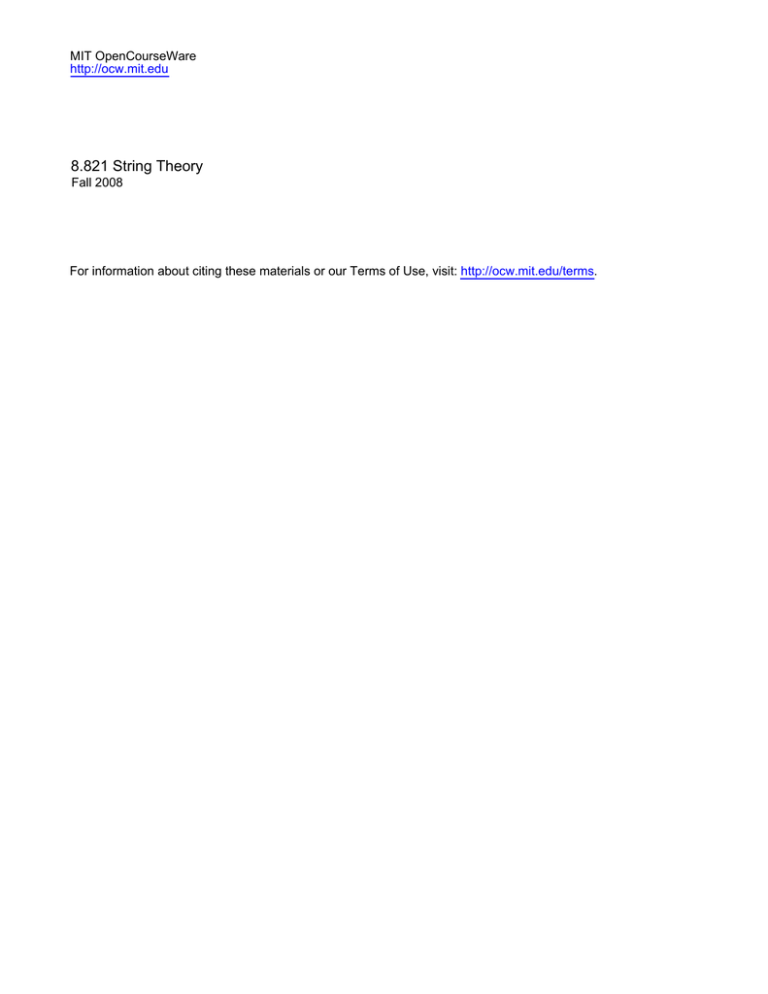
MIT OpenCourseWare http://ocw.mit.edu 8.821 String Theory Fall 2008 For information about citing these materials or our Terms of Use, visit: http://ocw.mit.edu/terms. 8.821 F2008 Lecture 02: String theory summary continued Lecturer: McGreevy Scribe: McGreevy Today: 1. problems with bosonic string 2. superstrings 3. D-branes Recall: Last time I was showing you how primitive is our description of string theory. Specifically, we are reduced to doing a path sum over worldsheet embeddings. To decouple timelike oscillators, we gauged the worldsheet conformal group. I told you that this leads to a theory of quantum gravity, which reduces to GR plus stuff at low energies. The spacetime effective action which summarizes the scattering amplitudes computed by the world­ sheet path integrals is � � �� �� � √ Sst [g, B, Φ...] ∼ dD x ge−2Φ R(D) + (∂Φ)2 + H 2 + ... 1 + O(α′ ) 1 + O(gs2 ) Here H = dB, meaning Hµνρ = ∂[µ Bνρ] , and H ∧ ⋆H = Hµνρ H µνρ To study other backgrounds (which are only weakly curved), we can try to study a worldsheet action in background fields (a nonlinear sigma model): � � � 1 2 √ µ ν αβ µ ν αβ (2) Sws[X] = d σ g g (X)∂ X ∂ X γ + B (X)∂ X ∂ X ǫ + Φ(X)R + ... (1) µν α µν α β β γ 4πα′ A few observations about this which we made in the first lecture: – conformal invariance constrains form of BG fields to solve spacetime EOM – the dilaton term implies that the contribution to the path sum of a worldsheets with more handles are weighted by more factors of gs = heΦ i – F-strings charged under B-field, and cannot end at some random point in spacetime. The specific objection to the ending of the string is the consistency of the Gauss’ law for the B-field. This arises from its equation of motion, which in the presence of a fundamental string looks like: 0= δSst = −d ⋆ H + δD−2 (string); δB 1 which arises by varying the action S[B] = � everywhere H ∧ ⋆H + � B string with respect to B. Integrating this (D-2)-form over a (D-2)-ball containing the string, we get the integrated gauss’ law: � ⋆H = Q1 , S D−3 the number of strings inside the (D-3)-sphere (4π is equal to one in this discussion). If the string ended suddenly, the answer here would depend on which choice we made for the interior of the S D−3 . problems: 1. bosonic string has a tachyon, a boson field with mass2 < 0. this is a real instability 2. conformal anomaly: under a scale transformation on a curved worldsheet, D − 26 (2) R δLws ∝ Tαα ∝ 2π 3. perturbation expansion does not converge. worse than QFT. e−1/gs . Problem 2 is ‘solved’ by string compactification: just study backgrounds where the dimensions you don’t like are too small to see. This is an interesting thing that we’re not going to talk about. To fix problem 1: superstrings. The ‘RNS’ description of superstrings is obtained from bosonic strings by changing the worldsheet gauge group to superconformal group – no tachyon, still graviton, B, dilaton AND spacetime fermions (which exist) – sometimes spacetime susy – Dc = 10. optimal for susy (will explain later) – The supersymmetric ones are the most interesting because we know their stable vacua. There are five flavors of 10d supersymmetric superstrings: IIB, IIA, type I, het E8 , het SO. There duality relations between all of them: they are descriptions of different probes of different states of the same theory. We will focus on the type II theories. They are very closely related to each other. At low energies, they reduce to type II supergravity, with 32 supercharges. A few words about the low-energy spectrum of type II. In addition to the fields which they share in common with the bosonic string, and the spacetime fermions, the type II strings (also type I has these) contain various antisymmetric tensor fields, called Ramond-Ramond (RR) fields. They are like Maxwell fields and like the B-field. They differ from the B-field in that strings are neutral under the associated gauge symmetry. Type IIA has RR potentials of every odd degree (and even-degree field strengths G = dC): C1 , C3 , C5 , C7 , C9 . They are related in pairs by EM duality (like F E = ⋆4 F B of E&M in 4d): e.g. the 1-form potential is the magnetic dual of the 7-form potential: dC1 = ⋆10 dC7 . 2 Type IIB has even-degree potentials, again related in pairs by EM duality. The middle-degree 5-form field strength is self-dual. (actually all of this is determined by supersymmetry.) The simplest duality relation, namely T-duality, is worth mentioning here if only to convince you that the two type II theories are not rival candidate theories of everything or something silly like that. [T-duality interlude: compactification of string theory on a circle is described on the worldsheet by making some of the fields periodic. Duality of 2d field theory relates strings on big circles to strings on small circles (in units of α′ ). The spectrum of strings on a circle is made up of a KK tower of momentum modes, and another tower of winding modes. T-duality interchanges the interpretation of these two towers. The basic idea is just that as the original circle shrinks, the winding modes of the strings start to look more and more like the continuum momentum modes on the big dual circle. In the type II superstring, this is accompanied by an interchange of the two flavors IIA and IIB. To relate the RR potentials: A RR-potential with an index along the circle being dualized loses that index; one without an index along the circle gains an extra index. ] (D-branes) re problem 3: the few insights beyond perturbation come from the following set of observations. The effective action (derived by expanding around particular solutions like flat space) can be used to find other solutions. If these solutions have small curvatures and field gradients (in string units) and if the dilaton is uniformly small, we can trust the leading-order effective action to tell us that it will really be a solution of string theory. In general, we don’t know a worldsheet description of most such solutions; the ones where the RR fluxes are nonzero are particularly intractable from the worldsheet point of view. One particularly interesting family of solutions are analogs of the Reissner-Nordstrom black hole solution of 4d Einstein-Maxwell theory, but which carry RR charge. An object which couples minimally to a p + 1-form potential (i.e. which carries the associated monopole moment) has a p + 1-dimensional worldvolume Σp+1 , so that we can have a term in the action of the form � � Sst ∋ Cp+1 = dσ α1 ...dσ αp+1 ǫα1 ..αp+1 ∂α1 X µ1 ...∂αp+1 X µp+1 Cµ1 ...µp+1 . Σp+1 In flat space, the stable configurations of such objects are just flat infinite p-dimensional planes in spacetime. These objects have a finite tension, and hence these are not finite-energy excitations above the vacuum; they are different superselection sectors. Nevertheless, they exist (they can preserve half the supersymmetry of the vacuum) and are interesting as we’ll see. If the space contains compact factors, we can imagine wrapping such objects on compact submanifolds and getting particle-like excitations. 3 The tension of these RR solitons is proportional to gs−1 . They are heavy at weak coupling, (though not as heavy as ordinary GR solitons, which have tension gs−2 ) and are not made of a finite number of fundamental string excitations. This means that the euclidean versions of these objects can contribute the mysterious effects of order e−Seucl ∼ e−1/gs . At weak coupling, it turns out that these objects have a remarkably simple description. We said earlier that the coupling to the NSNS B-field meant that string worldsheets can’t end just anywhere. A Dp-brane is defined to be a (p + 1)-dimensional locus where strings can end. The open strings which end there have tension and hence their light states are localized on the brane. These provide a string theory description of worldvolume degrees of freedom. We saw above that open string spectra contain vector fields; these worldvolume degrees of freedom very generally include a gauge field propagating in p + 1 dimensions. The physics of this vector field is gauge invariant. [It would be more interesting if it weren’t. This could be that this is just a result of the fact that we used the gauge principle in constructing the string theory.] So the leading term in the derivative expansion of the effective action for the gauge field is � 1 S = dp+1 x 2 tr F ∧ ⋆F + O(α′ ) gY M Because this action comes from interactions involving worldsheets with one boundary, it should go like gs2−2h−b = gs−1 and therefore gY2 M ∼ gs . In p + 1 dimensions, gY2 M has dimensions of lengthp−3 ; these are made up by powers of α′ . Strings have two ends. Each end can be labelled by which brane it ends on. This means that the string states are N × N matrices, where N is the number of D-branes. The ends of the strings are charged particles (quarks and antiquarks). We should try to understand how the ending of the string is consistent with the B-field gauge symmetry. To see this, we use the fact that the end of the string is a charged particle to guess that the coupling � of the worldsheet to a background worldvolume gauge field should take the minimal form SA = ∂Σ A where ∂Σ is the boundary of the worldsheet. The variation of the bulk worldsheet action under the B-field gauge transformation B → B + dΛ is � � 1 1 δSws = dΛ = Λ. 4πα′ Σ 4πα′ ∂Σ We can cancel this if we allow A to vary by A → A − 4πα′ Λ. This means that only the combination F ≡ 4πα′ F + B, where F = dA is invariant under the B-field gauge symmetry. Hence F must enter the effective action in this combination. To see how this story is modified by the presence of the brane, we need to think about the depen­ dence of the D-brane action on the B-field. Given our previous statement that the D-brane action contains L ∋ F ∧ ⋆F , it must actually be L ∋ F ∧ ⋆F. 4 Dp−brane B’8 7 S B8 string This means that in the presence of a fundamental string ending on a D-brane, the spacetime action for the NSNS B-field is � � � 10 ⋆B ∧ F + O(B 2 ) d x H ∧ ⋆H + B+2 S[B] = F1 everywhere Dp The equation of motion is then 0 = −d ⋆ H + δ8 (F 1) + δ10−(p+1) (Dp) ∧ ⋆F ; Integrating this over an 8-ball B8 that’s pierced by the string gives � ⋆H = n1 S7 where S 7 = ∂B8 is the boundary of the 8-ball and n1 is the number of strings. If we integrate instead over B8′ which is not pierced by the string, it must instead go through the D-brane, as in the figure. Integrating the EOM for B over B8′ gives � � ⋆H + ⋆F. 0=− S7 B8′ ∩Dp The first term here is the same as before, and is n1 . But this gives a consistent answer because � S 7 ∩Dp ⋆F is equal to the number of strings ending on the brane, by the gauss’ law for the worldvolume gauge field. Basically, the worldvolume gauge flux carries the string charge away. Note that IIA has D-branes of these dimensions: D0, D2, D4, D6, D8 The D0-brane is just a particle, charged under the RR vector field; The D6 is the associated magnetic charge. These are interchanged under T-duality with the branes of type IIB. while IIB has 5 D(-1), D1, D3, D5, D7, D9 The D9 brane fills space and is a big perturbation; they only exist stably in type I. The D(-1)-brane is pointlike in spacetime, and hence is best considered as a contribution to a euclidean path integral. It contributes e−1/gs effects to amplitudes. I forgot to say in lecture that these objects defined by new sectors of open strings can be shown to be charged under the RR tensor fields (and in fact saturate the Dirac quantization condition on the charge), and have tension 1/gs times the right power of α′ to make up the dimensions. The gravitational back-reaction of a stack of N parallel such D-branes is controlled by GN T ∝ gs N ≡ λ. When this quantity is small, the description in terms of open strings is good; when this quantity is large, the back-reaction is important and the better description is in terms of the gravitating soliton. More on this soon. 6
